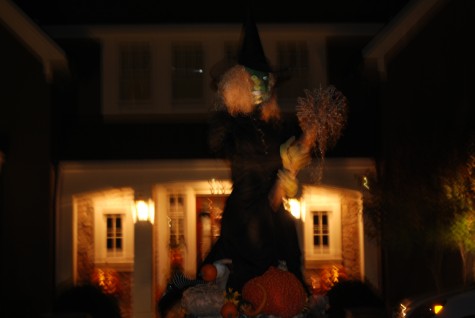 Fierce winds that went on for several days blew most of all the leaves on the trees to the ground. Yesterday what few leaves on my big maple that survived the initial blow, gave up, floated down, and landed on my drive with an audible sigh. I sighed too; November in Michigan is cold, blustery and unfriendly. My leaves usually fall over a period of weeks; this helps to get used to the idea that winter is not far off. But that all at once drop got me to looking at what is left behind. Tree bark-such beautiful skin.
Fierce winds that went on for several days blew most of all the leaves on the trees to the ground. Yesterday what few leaves on my big maple that survived the initial blow, gave up, floated down, and landed on my drive with an audible sigh. I sighed too; November in Michigan is cold, blustery and unfriendly. My leaves usually fall over a period of weeks; this helps to get used to the idea that winter is not far off. But that all at once drop got me to looking at what is left behind. Tree bark-such beautiful skin.
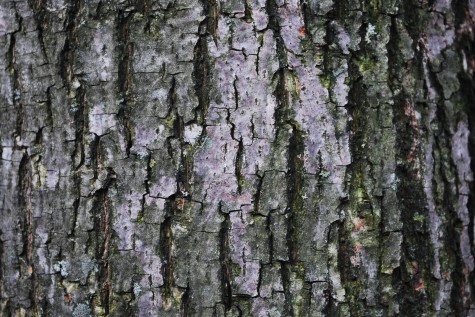 The bark of this linden is comprised of a number of layers-the outermost layer, or cork, is comprised of cells that are no longer living. This cork protects a tree in much the same way that skin protects people. The bark slows the loss of water from the interior living layers of bark. It is a deterrent to insect invasions, fungal and bacterial infection, and damage from animals.
The bark of this linden is comprised of a number of layers-the outermost layer, or cork, is comprised of cells that are no longer living. This cork protects a tree in much the same way that skin protects people. The bark slows the loss of water from the interior living layers of bark. It is a deterrent to insect invasions, fungal and bacterial infection, and damage from animals.
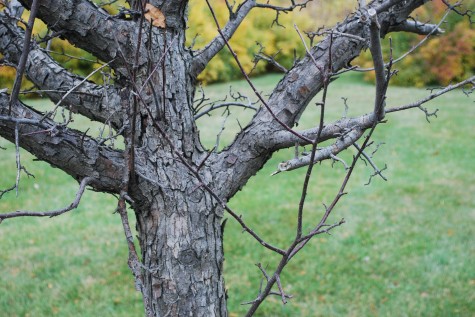 My skin surely reveals the amount of time I have spent outdoors; the trees are heir to all manner of insult from the environment that goes on non-stop. My corgi Milo has been trying to chase our resident squirrel up the trunk of my maple for three years now. His toenails have grooved the bark, but not damaged the tree. The variation in the appearance of tree bark makes it possible to identify trees by the bark alone; the diversity in plant forms is amazing. Old bark is beautiful in its texture and color. Rough, smooth, patchy, furrowed, scaly, exfoliating-we have so many words to describe the characteristics of bark.
My skin surely reveals the amount of time I have spent outdoors; the trees are heir to all manner of insult from the environment that goes on non-stop. My corgi Milo has been trying to chase our resident squirrel up the trunk of my maple for three years now. His toenails have grooved the bark, but not damaged the tree. The variation in the appearance of tree bark makes it possible to identify trees by the bark alone; the diversity in plant forms is amazing. Old bark is beautiful in its texture and color. Rough, smooth, patchy, furrowed, scaly, exfoliating-we have so many words to describe the characteristics of bark.
 The bark of a tree can be a host to all manner of mosses and lichens; some relationships are symbiotic. Other plants such as mistletoe, are parasites. Bark also protects a tree from sun scald, and frost cracks. In the summer, the horizontally held leaves of my maples protect its bark from sunburn. Lacking leaves, freezing and thawing in the winter can crack the part, and expose the inner living layers to pathogens. This big leaf linden conditions has many frost cracks which have just begun to heal.
The bark of a tree can be a host to all manner of mosses and lichens; some relationships are symbiotic. Other plants such as mistletoe, are parasites. Bark also protects a tree from sun scald, and frost cracks. In the summer, the horizontally held leaves of my maples protect its bark from sunburn. Lacking leaves, freezing and thawing in the winter can crack the part, and expose the inner living layers to pathogens. This big leaf linden conditions has many frost cracks which have just begun to heal.
 This old crabapple reveals many scars-some from pruning, some from insects-some just a result of age. The appearance of the bark is an important element in the selection of trees for the landscape. In Michigan, bark is the prominent visual feature of a tree for the better part of six months. The climax beech maple forests in the upper peninsula of Michigan are breathtakingly beautiful-as are the old cedars, and birches. The trees are so old, large and tall, most of what you see is all that gorgeous bark.
This old crabapple reveals many scars-some from pruning, some from insects-some just a result of age. The appearance of the bark is an important element in the selection of trees for the landscape. In Michigan, bark is the prominent visual feature of a tree for the better part of six months. The climax beech maple forests in the upper peninsula of Michigan are breathtakingly beautiful-as are the old cedars, and birches. The trees are so old, large and tall, most of what you see is all that gorgeous bark.
 The Popples, also known as Aspens, have very beautiful smooth bark that has a decidedly greenish cast. Its sepia colored ridges and furrows are equally as attractive. The stands of poplar trees on the slopes in Aspen are my favorite part of that landscape. Bungeana pines, old Kousa dogwoods, and London Plane trees shed their old bark; this process known as exfoliation is incredibly beautiful.
The Popples, also known as Aspens, have very beautiful smooth bark that has a decidedly greenish cast. Its sepia colored ridges and furrows are equally as attractive. The stands of poplar trees on the slopes in Aspen are my favorite part of that landscape. Bungeana pines, old Kousa dogwoods, and London Plane trees shed their old bark; this process known as exfoliation is incredibly beautiful.
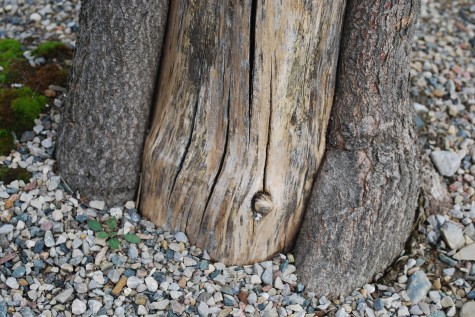 The bark of a tree will callus in response to a grave injury. This linden was struck hard by a careless driver; five years later it is still alive and thriving, though its woody interior is exposed on over one half of its trunk. The thickened bark is a healing response. Some bark grows thick enough such that it can be carefully harvested from a living tree use; this we call cork. The bark of the sequoia tree can grow as much as two feet thick-a proper scale for a tree of such great size.
The bark of a tree will callus in response to a grave injury. This linden was struck hard by a careless driver; five years later it is still alive and thriving, though its woody interior is exposed on over one half of its trunk. The thickened bark is a healing response. Some bark grows thick enough such that it can be carefully harvested from a living tree use; this we call cork. The bark of the sequoia tree can grow as much as two feet thick-a proper scale for a tree of such great size.
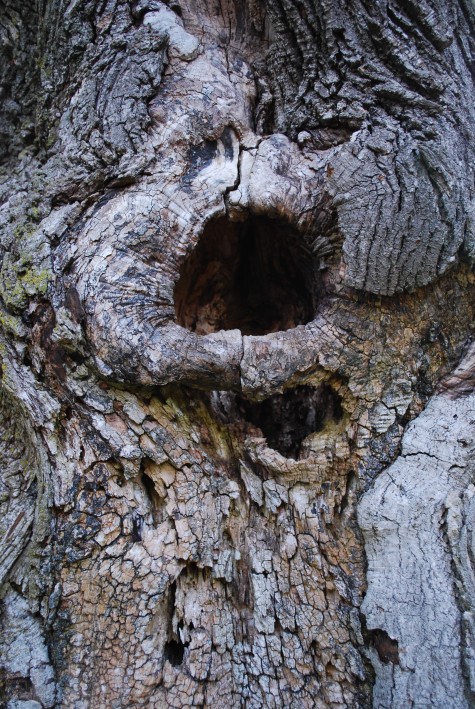 Though the bark protects the life of a tree, it does not protect forever. Like people, trees have a lifespan. This very old maple is in serious decline, partially from age. Trees with limited life spans may not be a good choice for a landscape you hope to have a long time.
Though the bark protects the life of a tree, it does not protect forever. Like people, trees have a lifespan. This very old maple is in serious decline, partially from age. Trees with limited life spans may not be a good choice for a landscape you hope to have a long time.
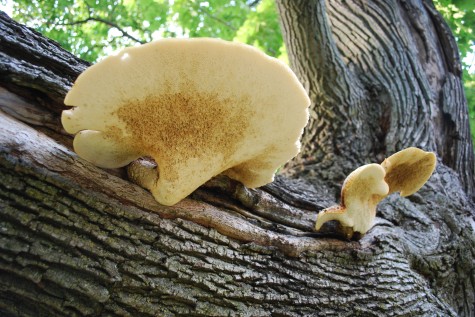
Fungus has managed to invade this maple via a crack in the bark that could not heal. This fruiting body of the fungus is a sure sign the tree will not survive much longer. But given how long they usually do survive and prosper, careful thought as to the selection and placement of the trees will benefit the landscape. Late fall is the perfect time to observe, enjoy, and plan around the beauty of the bark.
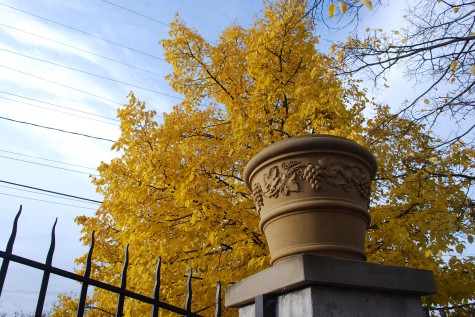 Tilia Cordata
Tilia Cordata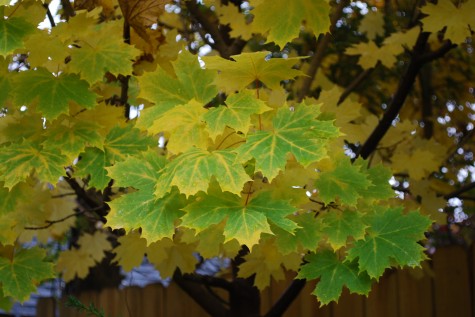 Acer Platanoides “Princeton Gold”
Acer Platanoides “Princeton Gold”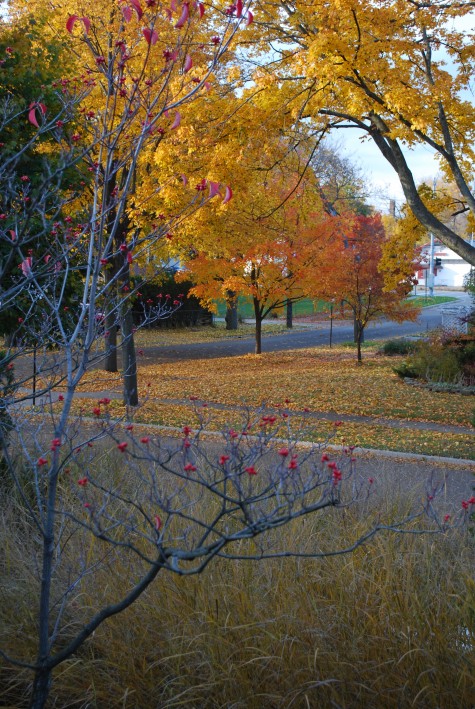 seeds Cornus Kousa
seeds Cornus Kousa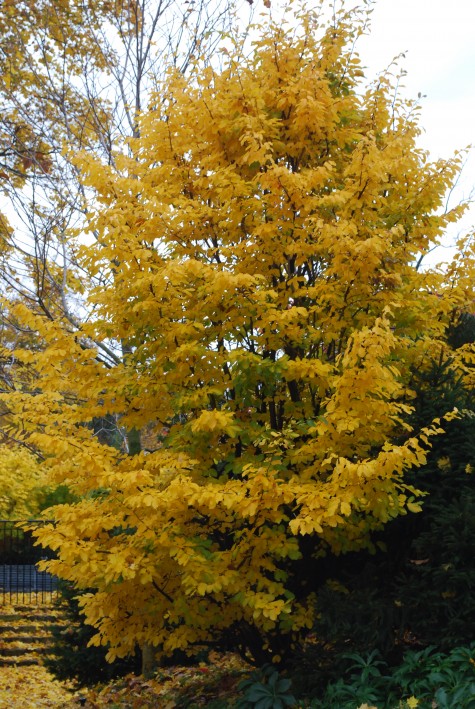 Parrotia Persica
Parrotia Persica Vitis
Vitis Betula Utilis var. Jacquemontii
Betula Utilis var. Jacquemontii Acer Platanoides “Princeton Gold”
Acer Platanoides “Princeton Gold”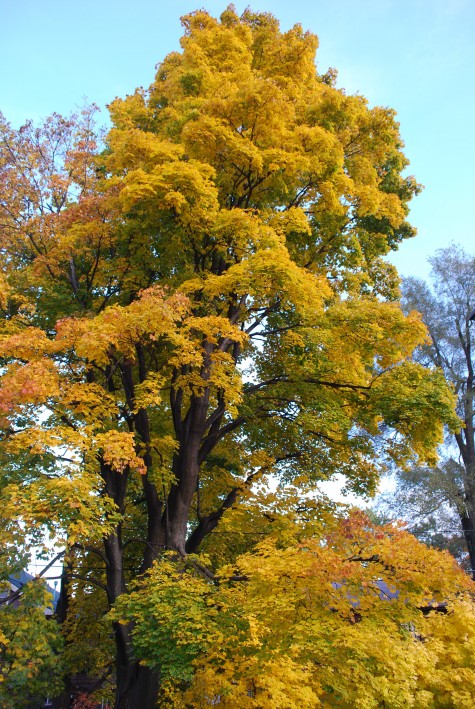 Acer Platanoides
Acer Platanoides Acer Platanoides
Acer Platanoides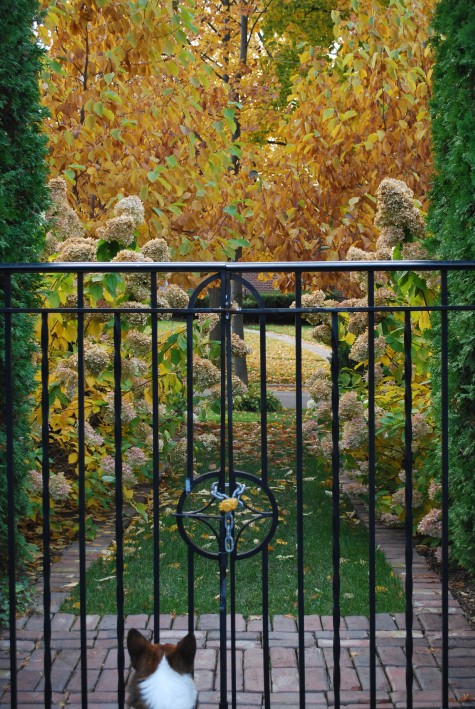 Magnolia x “Yellow Butterflies”
Magnolia x “Yellow Butterflies”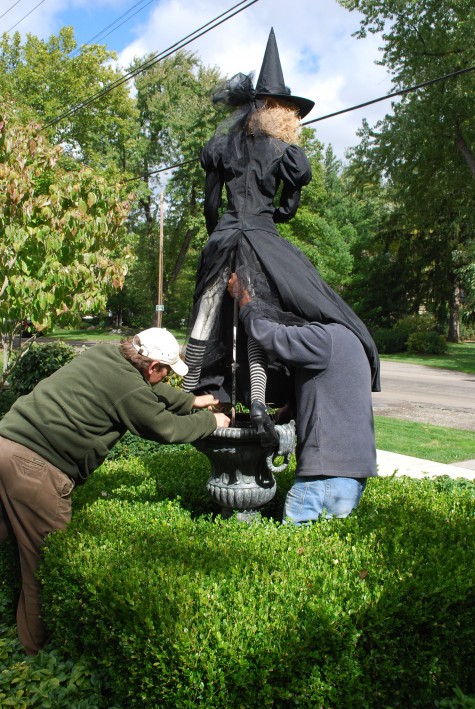 Outfitting an antique iron urn with a life size Halloween sculpture of the wicked witch of the west was my client’s idea. I think she is as wild about Halloween as her kids; she has a whimsically good spirit about her. So why not? Lauren, who is young enough to be able to locate and shop on line with lightening speed, found me a a posable standing aluminum mannekin covered in foam, with a polyester stretch knit covering. This figure was just waiting for an identity. The adjustable aluminum pole enabled us to set the height of the sculpture properly in the urn. The base plate went into the urn, and was stablilized with granite setts piled over top of it.
Outfitting an antique iron urn with a life size Halloween sculpture of the wicked witch of the west was my client’s idea. I think she is as wild about Halloween as her kids; she has a whimsically good spirit about her. So why not? Lauren, who is young enough to be able to locate and shop on line with lightening speed, found me a a posable standing aluminum mannekin covered in foam, with a polyester stretch knit covering. This figure was just waiting for an identity. The adjustable aluminum pole enabled us to set the height of the sculpture properly in the urn. The base plate went into the urn, and was stablilized with granite setts piled over top of it. Her vehicle was fashioned from a sharpened hickory fence pole, to which we attached black plastic grass; voila, a a suitably creepy broomstick. The gearshift knob is a stick ball, which I loaded with threads of industrial strength hot melt glue. For all the world it looks like she just flew through an industrial strength spider web. Or perhaps she has pet spiders that like go everywhere with her.
Her vehicle was fashioned from a sharpened hickory fence pole, to which we attached black plastic grass; voila, a a suitably creepy broomstick. The gearshift knob is a stick ball, which I loaded with threads of industrial strength hot melt glue. For all the world it looks like she just flew through an industrial strength spider web. Or perhaps she has pet spiders that like go everywhere with her.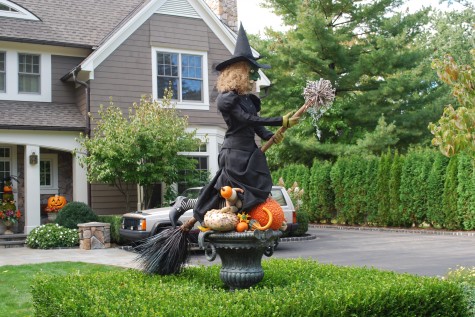 Apparently you can buy Halloween costumes in adult sizes. The outfit came complete with a suitably pointy hat with a tulle band, and the most fabulous pair of witchy shoes with flared heels and buckles. The striped socks and dirty chartreuse garden gloves came from Lauren. This girl is dressed to kill.
Apparently you can buy Halloween costumes in adult sizes. The outfit came complete with a suitably pointy hat with a tulle band, and the most fabulous pair of witchy shoes with flared heels and buckles. The striped socks and dirty chartreuse garden gloves came from Lauren. This girl is dressed to kill.  Her face is ghoulishly green perfection. We mechanically fastened the mask to the head of the mannequin; any part of the sculpture going askew as a result of our unpredictable October weather would not be good. One ping pong ball split in two is the basis for the eyes. They bulge out of the vinyl eye sockets in a terrifying way; Lauren painted on the chartreuse eyeballs, and exploded capillaries. Warty pumpkins and gourds cover the base plate. The decapitated fabric dolls-some with mini-pumpkin heads, are an especially gruesome touch.
Her face is ghoulishly green perfection. We mechanically fastened the mask to the head of the mannequin; any part of the sculpture going askew as a result of our unpredictable October weather would not be good. One ping pong ball split in two is the basis for the eyes. They bulge out of the vinyl eye sockets in a terrifying way; Lauren painted on the chartreuse eyeballs, and exploded capillaries. Warty pumpkins and gourds cover the base plate. The decapitated fabric dolls-some with mini-pumpkin heads, are an especially gruesome touch. A few finishing touches to the surrounding landscape, and our witch was ready for Halloween. This yard is decked out in spectacular anticipation of Halloween night. The whole process of the installation stopped traffic; lots of people like the fun that is Halloween.
A few finishing touches to the surrounding landscape, and our witch was ready for Halloween. This yard is decked out in spectacular anticipation of Halloween night. The whole process of the installation stopped traffic; lots of people like the fun that is Halloween. 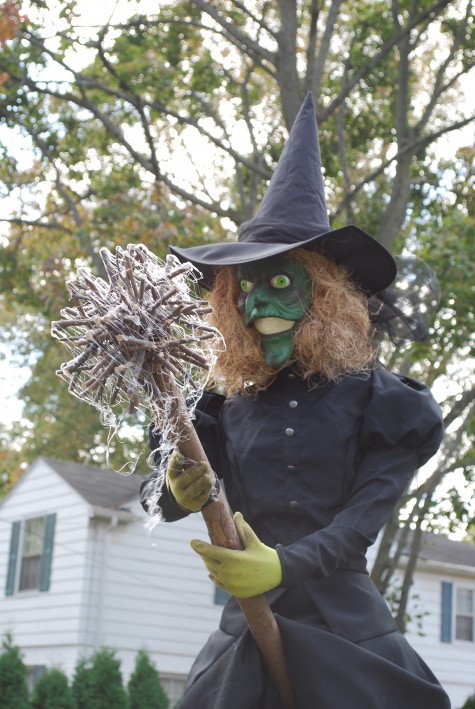 Her hemp fiber hairdo befits her; hemp stuffed into her hat makes the most of that pointed shape. Though I have not devoted too much time here to the construction, I chose all of the materials to start with the idea that rain and wind would not disturb them. Of course we had both the day after the installation. That polyester outfit shed the water, the tulle hat band held with water droplets to good effect. She has been flying across the yard for the better part of three weeks-looking good.
Her hemp fiber hairdo befits her; hemp stuffed into her hat makes the most of that pointed shape. Though I have not devoted too much time here to the construction, I chose all of the materials to start with the idea that rain and wind would not disturb them. Of course we had both the day after the installation. That polyester outfit shed the water, the tulle hat band held with water droplets to good effect. She has been flying across the yard for the better part of three weeks-looking good. 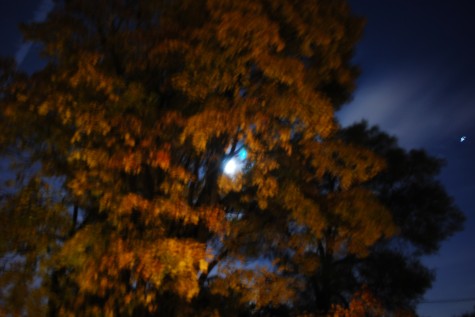 The night sky changes the appearance of everything. As is evident in the above picture taken last night, there will be a prominent moon tomorrow; I am always appreciative whenever nature cooperates.
The night sky changes the appearance of everything. As is evident in the above picture taken last night, there will be a prominent moon tomorrow; I am always appreciative whenever nature cooperates. The night light makes her appear all the more scary and threatening. Uplighting is the most garish and unattractive light possible in a landscape; this is working to great advantage here.
The night light makes her appear all the more scary and threatening. Uplighting is the most garish and unattractive light possible in a landscape; this is working to great advantage here. 